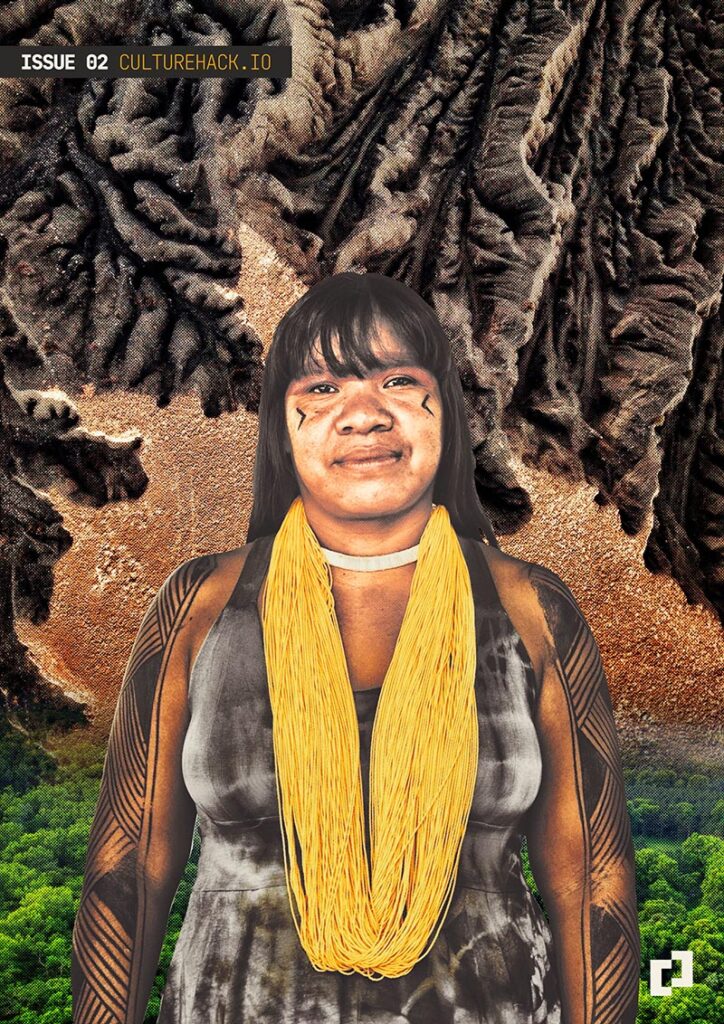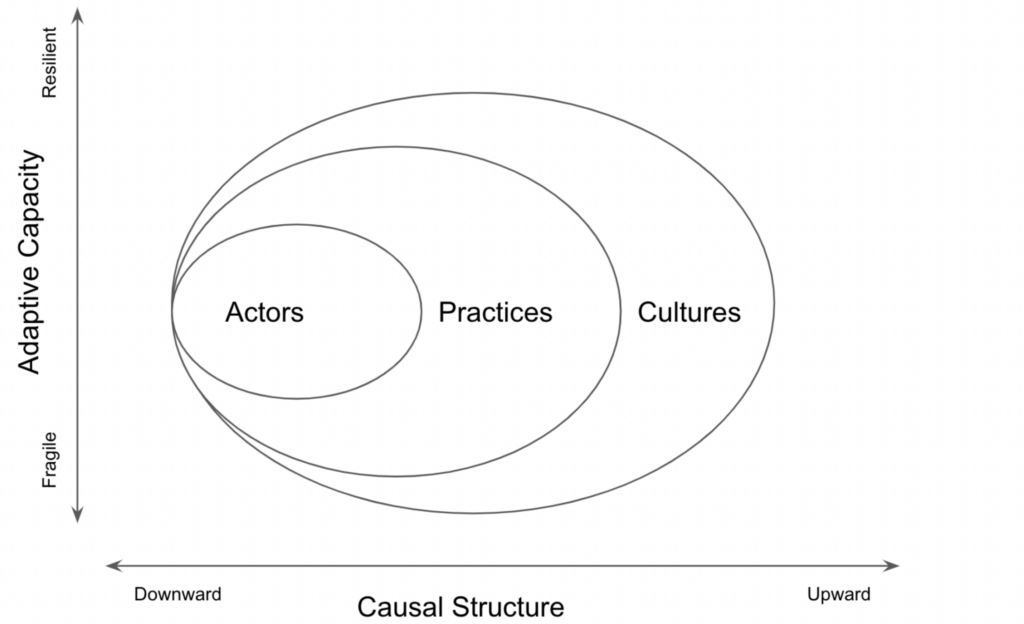Rethinking The Commons as an Evolutionary Capacity
A white paper from Culture Hack Labs on territories of transition

The goal of our work in the Territories of Transition initiative is to recast how we think about the commons: from a social and institutional form of collective ownership and governance towards the processural basis for transition, or cultural evolution. However this term, ‘cultural evolution’ needs to be disambiguated and recovered from the realm of social science and put to the task at hand. David Sloan Wilson grounds ‘cultural evolution’ within the larger context of evolutionary science. Wilson shows how symbolic thought is a key driver in major evolutionary transitions (MET), and more importantly how different this capacity is to mere associative learning. In this manner Wilson describes cultural evolution as the leading edge of biological evolution:
“Once the capacity for symbolic thought evolved, it became a full-blown inheritance system that operates alongside genetic evolution. Every one of us is a collection of genes, called our genotype, that influences nearly everything that can be measured about us, called our phenotype. Every one of us is also a collection of symbols—let’s call it our symbotype—that also influences nearly everything that can be measured about us—the very same phenotype. Our symbotypes and genotypes interact with each other, both during our lifetimes and over multigenerational time. For example, a course in meditation, which alters your state of mind, upregulates or down-regulates a substantial fraction of your genes.”
To get a better grasp of this, and its impact on our understanding of the narrative space, we need to describe major evolutionary transitions (MET) and multilevel selection (MS) and their relationship to this capacity for symbolic thought. Wilson (2021) points to this relationship by stating that even though we share 99% of our genes with chimpanzees there is a night and day difference in the level of cooperation, and that the capacity for symbolic thought is the apex of this cooperative capacity that differentiates humans. More specifically, he indicates that it was ‘social control’ or the ‘down regulation’ of individual behavior for the greater benefit of the group, that was the defining aspect of the human evolutionary trajectory. This is a cultural process, meaning that higher levels of cooperation are possible due to the development of cultural forms that coordinate human activity around specific values, norms and ethical imperatives.
Delving a little deeper here into this capacity for cultural evolution, we can define major evolutionary transitions as the emergence of new wholes due to novel capacities of cooperation between parts. This conception of evolution grounded in cooperation, was first described by Lynn Margulis (1970) then later formalized by Szathmáty and Maynard Smith (1995), and truly transforms the evolutionary principle from imperatives of individual fitness to that of collective fitness. This in turn relates to multilevel selection theory, another well established evolutionary theory that emphasizes cooperation as the key evolutionary mechanism. It assumes that within any population of evolving individuals there are smaller groups in which social interactions occur. Moreover, within each of these groups natural selection favors the strategies that maximize the fitness of individuals relative to other members of the same group (Wilson, et al., 2013) – the metric here is ‘relative fitness’ not absolute fitness.
In their paper Generalizing the core design principles for the efficacy of groups, Wilson, Ostrom and Cox (2013), employ this principle of relative fitness in understanding the commons from an evolutionary perspective. Building on Ostrom’s eight design principles, they develop the following principles as an integration of the evolutionary principles in MLS:
- Clearly defined boundaries. All examples of major evolutionary transitions involve groups with clear boundaries, such as the cell walls and nests for eusocial insects…ancestral human social interactions were typically conducted in small groups whose membership (e.g. those present), objectives (e.g. hunting, gathering, raiding and migrating), and their actions were obvious to everyone.
- Proportional equivalence between benefits and costs. When costs and benefits are not proportional, some members of the group benefit at the expense of others (within-group selection) and group-level selection must be correspondingly strong for group-level adaptations to evolve. When costs and benefits are proportional,then selection differentials within the group are eliminated and between-group selection is unopposed. In general, the more proportionality is established within groups, the stronger between-group selection will be, relative to within-group selection.
- Collective-choice arrangements. Consensus decision-making provides a safeguard against decisions imposed by some members of the group at the expense of others, since group members will not agree to arrangements that place them at a disadvantage.
- Monitoring. Earlier we stated that within-group selection is suppressed only by virtue of an arsenal of mechanisms that keep it under control. Monitoring is an essential part of the arsenal.
- Graduated sanctions. One reason that we are a highly group-selected species is because group members can impose extreme costs on miscreants at low cost to themselves.
- Conflict resolution mechanisms. As with proportional equivalence and collective-choice arrangements, fair conflict resolution mechanisms act as a safeguard against exploitation within groups.
- Minimal recognition of rights to organize. This design principle only becomes relevant in large-scale societies composed of subgroups. For the vast stretch of our evolutionary history, all groups were small groups responsible for their own organization.
- For groups that are part of larger social systems, there must be appropriate coordination among relevant groups. This design principle is also restricted to large-scale societies and can be best understood in terms of multilevel selection operating on a multi-tiered population structure.
Through this refined conception of the commons, as the locus for higher forms of cooperation and therefore spaces in which relative fitness can be maximized, we can begin to understand the commons through a new perspective. Rather than merely the collective management of common pool resources (as the commons is popularly conceived), the evolutionary cooperation model views the commons as the very locus from which evolutionary transitions may occur. This is a critical insight given the current meta-crisis we face as a civilization.
In conjunction to this, and within the major transition we are currently enmeshed within, this is also a political process. Peter Turchin for example uses MLS to describe the rise and fall of empires. He shows how cultures, nations and empires form through the cooperation of groups of highly connected individuals that are united through a shared belief system or telos. However as self-serving strategies once again become dominant in these civilizations, inequalities arise that lead to collapse.
Through this, we can discern two principles as they pertain to this socio-political process. Firstly, the higher levels of cooperation necessary for transitions are brought about through a shared system of beliefs, a common culture that is codified in everyday practices. Secondly, the lifecycle of emerging novel cultural forms is reliant on their ability to maintain the capacity to serve individual interests relative to the whole i.e. the capacity to maintain the flourishing of individuals at every scale of the system. If this is not maintained, breakdowns occur, leading to a reformulation of the underlying belief systems, creating either new orienting logics or splintering of the group into smaller groups.
Perhaps one of the most important critiques of Turchin’s work and indeed also Sloan et al. is they are fundamentally anthropocentric in their cosmology – even though both show the relationship between cultures and cooperation, they remain neutral to the nature of these cultures as they pertain to interdependent evolutionary trajectories with the living world.
In our white paper, Culture and the Anthropocene we articulate a model of culture based on three dimensions – 1.the conception/definition of “Self”, 2. the conception/definition of “Other” and 3. the constructs that define the relationship between “Self” and “Other”. Furthermore, we can see that in more resilient cultures there is a far more integrated relationship between Self and Other, that is to say the constructs or orienting belief systems emphasize contingency and interdependence. Therefore the cultural aspects, those symbolic systems that circumscribe the domain of truth, are the highest level constraint determining the resilience of said system.
The Evolutionary Commons
Rethinking the evolutionary potential of the commons, we can start building a model that shows three key aspects: actors, practices and cultures.

- Actors: This aspect describes all those individuals which make up the collective and who have agency. Importantly who and what are considered viable ‘actors’ within the system is largely determined by the cultural aspects of the system. For example in certain Indigenous cultural systems, the land, trees, rivers and other beings are all necessary and participating actors in the deep ecology of place and time.
- Practices: Refers to the principles of cooperation between actors/individuals as they aim to maximize individual fitness as it pertains to the whole (relative fitness). Once again the basis of understanding of this relationship of part to whole, is completely determined by the cultural modes and dispositions. Ostrom’s eight principles are the archetypal example of this aspect as they relate to the everyday practices of cultivating and maintaining a shared purpose.
- Cultures: This aspect describes the cultural system that coordinates the whole. In this model, we are specifically describing the relationship between what is considered as Self and what is considered to be Other.
In addition to this, there are two spectrums/dimensions within which we can better measure the evolutionary capacity of these systems. The Adaptive Capacity spectrum indicates that the system is within a continuum in which novelty and uncertainty exist, and that the system must continually adapt to. This adaptive capacity (whether the system is fragile or resilient), is wholly determined by the capacity to maintain the individual-to-whole relationships as it pertains to this metric of relative fitness. Secondly, the Causal Structure spectrum indicates that the emergent cooperative system is a result of the interaction of parts/actors (upward causative means), the mediating practices (coordination) of everyday life, and the normative forces of cultural systems (downward causative means). This model allows us to begin to think about the commons in a new way, a perspective from which we can evaluate both the adaptive/evolutionary capacity of the system; but also the degree to which culture impedes or supports evolution.
Footnotes
- Reintroducing Pierre Teilhard de Chardin to Modern Evolutionary Science (2021)
- Maynard Smith, John; Szathmáry, Eörs (1995). The Major Transitions in Evolution. Oxford, England: Oxford University Press; Margulis, L., 1970. Origin of Eukaryotic Cells. Yale University Press, New Haven.
- In this instance, the term ‘wholes’ refers to novel forms, as they relate to new forms of life but also new cultures and social practices,
- Okasha, S., 2006. Evolution and the Levels of Selection. Oxford University Press, Oxford.; Wilson, D.S., Kniffin, K.M., 1999. Multilevel selection and the social transmission of behavior. Human Nature 10, 291–310;Wilson, D.S., Timmel, J., Miller, R.R., 2004. Cognitive cooperation: when the going gets tough, think as a group. Human Nature 15, 225–250.; Wilson, D.S., Wilson, E.O., 2007. Rethinking the theoretical foundation of sociobiology. Quarterly Review of Biology 82, 327–348. Wilson, E.O., Hölldobler, B., 2005. Eusociality: origin and consequences. Proceedings of the National Academy of Sciences of the United States of America 102, 13367–13371
- Wilson, D.S., et al., Generalizing the core design principles for the efficacy of groups. J. Econ. Behav. Organ. (2013),
- Turchin, P., 2005. War and Peace and War. Pi Press, Upper Saddle River, NJ.
- See Lance H. Gunderson and C.S. Holling, eds. (2002), Panarchy, especially chapter 2, “Resilience and Adaptive Cycles”.
- For a detailed description of how Holling and Gunderson’s Panarchy may be applied to the transition, see https://leanlogic.online/glossary/wheel-of-life-the/
